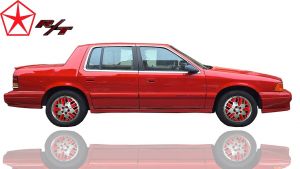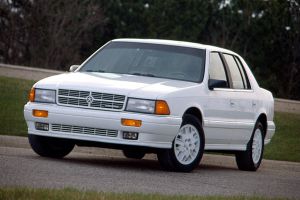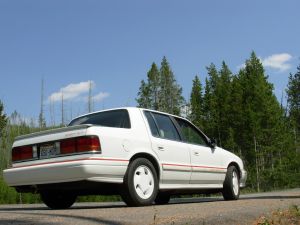Difference between revisions of "1989-1995 Dodge Spirit"
Old Hippie (talk | contribs) |
Old Hippie (talk | contribs) |
||
| (4 intermediate revisions by the same user not shown) | |||
| Line 8: | Line 8: | ||
<!-- The below are the photos that line up on the right side. Use the Upload link to upload photos of this car model and replace the uploaded image name and the photo's description in the below. Again more information is in the understanding wikis title in the sidebar --> | <!-- The below are the photos that line up on the right side. Use the Upload link to upload photos of this car model and replace the uploaded image name and the photo's description in the below. Again more information is in the understanding wikis title in the sidebar --> | ||
| − | [[Image: | + | [[Image:DodgeSpiritRT.jpg|thumb|300px|1991 Dodge Spirit R/T]] |
| − | [[Image: | + | [[Image:91SpititES.jpg|thumb|300px|1991 Dodge Spirit ES]] |
| − | [[Image: | + | [[Image:92Dodgespirit.jpg|thumb|300px|1992 Dodge Spirit]] |
| − | |||
| − | |||
| − | |||
== Background == <!-- Do not remove this line As it is a heading --> | == Background == <!-- Do not remove this line As it is a heading --> | ||
| Line 169: | Line 166: | ||
* [https://www.moparweb.com/forums/ MoparWeb.com] | * [https://www.moparweb.com/forums/ MoparWeb.com] | ||
* [https://en.wikipedia.org/wiki/Dodge_Spirit Wikipedia] | * [https://en.wikipedia.org/wiki/Dodge_Spirit Wikipedia] | ||
| + | * [https://consumerguide.com/used/1990-95-dodge-spirit/ Consumer Guide] | ||
{{Template:BottomWiki}} <!-- Do not remove this line --> | {{Template:BottomWiki}} <!-- Do not remove this line --> | ||
Latest revision as of 04:21, 8 July 2021
The Dodge Spirit is a mid-size 5- or 6-passenger sedan that was introduced in January 1989 as a replacement for the similarly sized Dodge 600. The Spirit was Dodge's version of the Chrysler AA platform, a stretched variation of the Chrysler K platform. It was assembled at Newark Assembly in Newark, Delaware, Toluca Car Assembly in Toluca, Mexico, as well as Valencia, Venezuela, and shared its basic design with the 1990 to 1994 Chrysler LeBaron sedan, the 1989 to 1995 Plymouth Acclaim, and the export-only 1989 to 1995 Chrysler Saratoga.
The Spirit has also been described as a replacement for the smaller Aries and the hatchback Lancer, though the Shadow launched in 1986 is closer than the Spirit in most dimensions to the Aries and Lancer. A total of 60,000 Dodge Spirits were sold in its first year, enough that Aries production was stopped mid-season. Spirit production ended on 9 December 1994, along with the Plymouth Acclaim and it was marketed through 1995. The "cab-forward" Stratus was introduced as a replacement.
Background
Trims
- 1989–95: Base
- 1989–91: LE
- 1989–93: ES
- 1991–92: R/T
The Spirit ES and R/T featured Eurocast (also called Snowflake) alloy wheels through 1991. For 1992, the Turbo Blade wheel was introduced. Some of the alloy wheels were color-keyed to the vehicle body:
- White body with white painted wheels (ES, R/T)
- Black, silver, or dark red body with clear-coated wheels (ES only)
- Bright Red body with bright red painted wheel inserts (R/T only, 1991)
Starting in 1993, the Spirit was offered with a Gold package similar to that offered on the 1993-94 Plymouth Acclaim and Dodge Caravan/Plymouth Voyager minivans. This included goldtone-trimmed alloy wheels and gold pinstripes. The Gold package was available with both 4- and 6-cylinder models, with certain body colors.
Model Predecessor
- Dodge 600
- Dodge Aries
- Dodge Lancer
Model Successor
- Dodge Stratus (sedan)
Export Version(s)
Spirits were marketed in Mexico
They were badged as Chryslers rather than Dodges, since the Dodge brand at the time was used only on trucks. The Spirit was introduced in the Mexican market for 1990, one year after its début in the U.S. and Canada. The 1990-1991 Mexican versions were equipped with the U.S. market Plymouth Acclaim tail lights. The initial 1990-model Spirits used a version of the 2.5L engine operating on leaded gasoline, equipped with a carburetor, a tubular exhaust header, and electronic control of ignition timing. This induction and ignition system used technology and components very similar to those employed in Chrysler's U.S.-market Lean Burn emission control systems of the late-1970s.
For the 1991 model year, Mexico enacted new-vehicle emission regulations similar to those in the U.S. and Canada. The carbureted leaded-fuel engine was too dirty to comply with the new regulations, so a fully integrated engine management system with fuel injection was added to the Spirit. This was not the TBI system used in the U.S., Canada, and Europe. Rather, the Mexican-market Spirits came with a more advanced MPFI setup. The MPFI 2.5 improved performance and driveability, as well as achieved cleaner emissions than its TBI counterpart, but was not used in the U.S., Canadian, or rest-of-world export markets except on turbocharged and FFV models. The Chrysler Spirit with MPFI 2.5 L engine was sold in Mexico from 1991 through 1995, and was exported to Argentina and Brazil from 1993 through 1995. It was employed by the Argentine police in Buenos Aires.
Chrysler Spirit, police car in Argentina
Chrysler de Mexico also sold two versions of the Spirit R/T. The base R/T, sold from 1991 through 1995, used a Mexico-only 168 hp (125 kW; 170 PS) intercooled Turbo II version of the 8-valve SOHC 2.5L engine and the 3-speed A413 automatic transmission. These R/Ts were used by Mexican police departments.
The top-line R/T. called "R/T DOHC", available from 1992 through 1993, came with the same 2.2L 16-valve DOHC engine that was used in the American-market from 1991 to 1992 R/T with a 5-speed manual transmission. More options and higher equipment levels were available in Mexico, including leather upholstery, sunroof, and 16-inch alloy wheels, none of which was offered on the R/T in America. In addition, Mexican-market R/Ts could be ordered in a variety of different colors, not just the red, white, and silver offered in the U.S. All Mexican-market Spirit R/Ts were badged as Chryslers. A variant of the R/T family, the Chrysler Phantom R/T, was a special-order Mexico-only premium version of the LeBaron coupe equipped with the 2.2 L 16-valve DOHC engine and the Getrag 5-speed manual transmission.
Related Corporate
- Chrysler LeBaron
- Chrysler Saratoga
- Plymouth Acclaim
Direct Competition
Technical
Price Class
Platform
Available Engines
- 2.2 L Turbo III I4
- 2.5 L K I4
- 2.5 L K Turbo I4
- 3.0 L Mitsubishi 6G72 V6
The base engine for Spirit and Spirit LE models was a 2.5 L (150 cu in) TBI 4-cylinder engine producing 100 hp (75 kW; 101 PS). Optional on all models except the Spirit R/T was a 141 hp (105 kW; 143 PS), 3.0 L (180 cu in) L V6 made by Mitsubishi. Also available in 1989 through 1992—and standard equipment on the Spirit ES—was a 150 hp (112 kW; 152 PS) turbocharged version of the 2.5 L engine. In 1993, 1994, and 1995, a flexible-fuel Spirit was offered, powered by a 107 hp (80 kW; 108 PS) multipoint fuel injected version of the 2.5 L engine specially modified to run on fuel containing up to 85% methanol. The R/T version came with a powerful 2.2 L (135 cu in) DOHC turbo III with cylinder head engineered and made by Lotus. This engine was rated at 224 hp (167 kW; 227 PS) and 217 lb⋅ft (294 N⋅m).
Available Transmissions
- 5-speed A523 manual
- 5-speed A568 manual
- 3-speed A413 automatic
- 3-speed A670 automatic
- 4-speed A604 automatic
Several five-speed manual transmissions were available with the naturally aspirated and turbocharged 4-cylinder engines, but relatively few Spirits were equipped with manual transmissions. All the Spirit R/Ts came with the A-568 heavy-duty 5-speed manual transmission. From 1989 to 1991, all V6 Spirits came with the electronic four-speed A604 overdrive automatic, which became optional equipment in 1992 and remained optional until 1995. The three-speed Torqueflite automatic was the most popular installation on 4-cylinder Spirits, and was also standard equipment with the V6 engine from 1992 through 1995. A 5-speed manual was offered with the V6 engine in the smaller Shadow, but this combination was not available in the Spirit.
Overall Length
- 181.2 in
Overall Width
- 1991–95: 68.1 in
- 1989–1990: 67.3 in
Height
- 53.5 in (1,359 mm)
Wheelbase
- 1991–95: 68.1 in
- 1989–1990: 67.3 in
Front/Rear Track
Curb Weight
- 2,901 lb (1,316 kg)
Sales
| Calendar Year | United States |
|---|---|
| 1989<ref>Template:Cite web</ref> | 68,661 |
| 1990 | 99,319 |
| 1991 | 97,242 |
| 1992 | 78,719 |
| 1993 | 62,951 |
| 1994 | 42,443 |
| 1995 | 12,991 |
| Total sales | 462,326 |
Owner/Driver Impressions
Name of Reviewer
References
Books & Magazine References
Internet
Random Page | Longest Wikis | Oldest Wikis | Newest Images | Newest Wikis | List of Categories | List of Every Freakin Wiki
- Register to Edit
- It takes less than 5 minutes to request registration for editing, and we try to approve within 24 hours. Click the Register Link in the Top Bar.
- MoparWiki Help
- While editing Wikis may at first glance appear a little overwhelming, it really isn't. You will find this site's HELP (link found in the sidebar) to be very strong and easy to understand. The best way to start is with small edits and working on your user page -- and you will become a Pro in no time.
Change the Category below the Comments to the appropriate category(s). In the special pages you will find a link to the list of categories.




